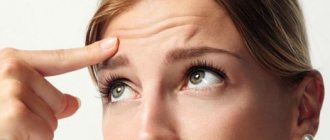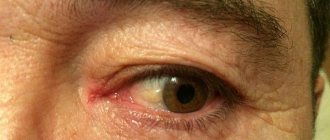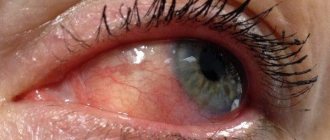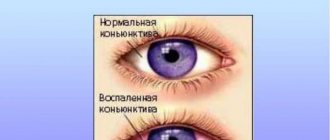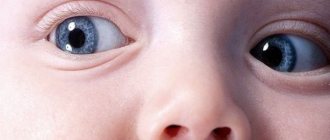Explanation
Let's analyze why the head hurts and puts pressure on the eyes. Reasons for each specific case:
- Overvoltage. Occurs when there is excessive strain on the eyes - this is a prolonged stay at the computer, preparing students for exams. Also, a headache in this case may be associated with some kind of stressful situations or emotional breakdowns. If you have an incorrect posture while sleeping or at the computer, pain may appear due to muscle strain: in the back, neck, and head. Usually the nature of the pain is compressive, moderate intensity.
- Migraine is often a hereditary disease. It is characterized by acute, throbbing pain, involving half of the head: that is, the eye, forehead and temple on the right or left.
- Increased intracranial pressure. The pressure increases due to an increase in cerebrospinal fluid, which stretches the arachnoid membrane of the brain. And this stretching causes pain in the head. It is typical that the pain intensifies in the morning.
- Neoplasms of the brain. The outflow of cerebrospinal fluid is obstructed, therefore intracranial pressure increases. Also, neoplasms put pressure on certain areas of the brain, which causes headaches.
- Pathologies of cerebral vessels. They can be congenital, for example arteriovenous malformation, or acquired, for example atherosclerosis. With these diseases, the pain is similar to that that occurs with migraine.
- Infectious diseases of the brain: encephalitis, meningitis are serious diseases that can result in death if not treated in a timely manner. Very severe headaches around the eyes and neck.
- Inflammatory diseases. Inflammation of the maxillary sinuses, sinusitis. Headaches are caused by intoxication of the body. Along with the headache, a rise in temperature and runny nose are noticed.
- Inflammation of the trigeminal nerve is one of the most painful types of pain. The pain, like an electric shock, can be localized near the nose and in the eye area.
- Toothache. Pain in the frontal region of the head occurs when the incisors are damaged.
- Allergy. Headache and pressure on the eyes combined with other symptoms characteristic of allergies. Unpleasant feeling.
- Increased eye pressure. Occurs with glaucoma, colds and inflammatory processes in the eyes. There is a pressing pain in the eyes, and a headache mainly in the forehead area.
- Traumatic brain injuries: there are open and closed. Depending on the severity of the injury, headaches can last for months or even years.
- Women suffer from headaches during menopause, during PMS, and also during pregnancy.
- In hypertension, headaches are caused by increased intracranial pressure, muscle pain, and ischemic pain (poor blood circulation to the brain). With hypotension, headache occurs due to fluctuations in vascular tone.
- Osteochondrosis. If the headache is provoked by muscle contractions, then the pain is dull. Vertebral artery syndrome is involved - burning pain. An additional symptom may be pressing pain in the eyes.
- Reflex headache. Occurs with diseases of internal organs (stomach, liver, intestines), astigmatism, incorrectly selected glasses, adenoids and other diseases.
- Chemical poisoning. Almost all poisonings: drugs, varnishes, paints, pesticides and others cause a headache and pressure on the eyes.
- Bad habits, such as smoking, alcoholism, drug addiction, also cause headaches due to spasms of blood vessels, in particular the blood vessels of the brain.
- Mental illnesses are accompanied by headaches.
My right eye and my head hurt on the right after an injury
After a mechanical injury to the skull, a person experiences pain in the right side of the head, radiating to the eye. Gradually, the unpleasant pulsating sensations may shift slightly to the neck or back of the head. With a traumatic brain injury, a person loses orientation in space, and the patient may begin to vomit. Even a minor bruise of the skull can have extremely negative consequences for the health and life of the patient. Therefore, immediately after a fall or blow to the head, you should immediately seek help from a doctor.
A head injury must be treated under the supervision of a doctor.
Often, after a head injury, an internal hematoma forms in the brain. This disease is manifested by the following symptoms:
- From time to time the patient experiences severe convulsions;
- Lethargy appears, consciousness becomes confused;
- Blood pressure drops significantly, attacks of nausea begin;
- The right or left side of the head hurts, radiates to the eye.
This pathology needs to be treated for a long time and carefully under the strict supervision of doctors. If the patient's condition does not improve, surgery may be necessary.
With a concussion, almost similar symptoms can be observed in the victim. The pain can last from several hours to several days, depending on the severity of the injury and the individual characteristics of the patient.
Even if after 1-2 days the patient’s condition has improved, it is necessary to consult a doctor and undergo a medical examination. Untreated concussion is the most common cause of chronic attacks of cephalalgia.
Causes of headaches pressing on the eyes
One of the most common clinical manifestations of various diseases is headache. The nature of this symptom may vary depending on the etiology. Some of the most common causes of headaches pressing on the eyes include:
- poisoning with toxic substances, alcohol or food;
- concussions;
- bruises;
- fractures of different parts of the skull;
- osteochondrosis of the cervical spine;
- increased intraocular pressure;
- allergy;
- trigeminal or optic neuralgia;
- conjunctivitis;
- myopia;
- glaucoma;
- astigmatism.
Headache in the forehead and nausea
If nausea is added to a headache and a feeling of pressure in the eyes, this indicates a disruption in the functioning of the nervous or cardiovascular system. As a rule, such a clinical picture accompanies injuries (concussions, skull fractures), but there are other reasons:
- Migraine. A pathology of a chronic nature, in which patients complain of severe throbbing pain, nausea, vomiting, tinnitus, weakness, and complete loss of performance.
- Hypertension. A disease caused by a persistent increase in blood pressure. Accompanied by darkening of the eyes, nausea, and headache.
- Hypotension. Excessively low blood pressure due to insufficient vascular tone provokes oxygen starvation of brain tissue. Hypotension is characterized by pain in the eyes, weakness, drowsiness, loss of consciousness with a sudden change in body position.
Headache in the forehead and eyes
Stuffy nose
The presence of nasal congestion accompanied by headaches and pressure in the eyes indicates pathologies of the ENT organs. These include:
- Frontit. Inflammatory lesion of the mucous tissue of the frontal sinuses. With frontal sinusitis, the patient complains of a runny nose (sometimes purulent), photosensitivity, and increased body temperature.
- Sinusitis. Inflammation of the mucous membrane of the maxillary sinuses. A distinctive feature of sinusitis is a constant headache.
- Ethmoiditis. Inflammation of the mucous membrane of the ethmoid sinus. Characterized by swelling of the mucous membrane, headache, and tension in the eyes.
In addition, headaches, nasal congestion and a feeling of pressure in the eyes occur with tumors of the nasopharynx. The main difference between pathology and the inflammatory process is the absence of mucous or purulent discharge from the nose and an increase in body temperature. The neoplasm compresses neighboring tissues, resulting in hearing, vision, smell, and voice changes.
Headache, pressure on the eye and fever
With the development of inflammatory foci of different localization, the patient's temperature rises. The main reasons for the development of such clinical symptoms:
- respiratory infections (ARVI);
- flu;
- cold;
- meningitis (inflammation of the meninges);
- encephalitis (inflammation of brain tissue).
During pregnancy
If the frontal part of the head and eyes hurt during pregnancy, this often signals physical or emotional stress, the development of a serious pathology in the body. As a rule, women complain about such symptoms in the last weeks of pregnancy, which is due to the heavy load on the kidneys, the accumulation of fluid in the body, weight gain and increased blood pressure.
In addition, during the gestation period, significant changes in hormonal levels occur, and the work of all organs and systems is restructured. Often a headache occurs in the forehead due to spasms of cerebral vessels, migraine attacks that develop due to an increased amount of progesterone in the blood, a decrease in the secretion of the neurotransmitters dopamine and serotonin. The immunity of the expectant mother during pregnancy is reduced, so there is a high risk of developing sinusitis, otitis, infection with ARVI (acute respiratory viral infection), and influenza.
Headache during pregnancy
Causes
The reasons may vary; according to statistical data, it is possible to identify 5 main factors that provoke pain near the forehead and eyes:
- Trauma.
- Pathologies of the blood vessels of the head.
- Viruses and bacteria.
- Uncomfortable position of the head and cervical region.
- Lack of daily routine, nervousness.
Often the pain spreads to the forehead and eyes after prolonged intellectual work, as a result of stress. There is a feeling:
- Compression of the head.
- General weakness of the body.
- The patient is feeling nauseous.
The constant manifestation of symptoms in the frontal region signals illness or an inappropriate lifestyle. To determine the causes and ways to relieve symptoms, diagnostics are carried out.
It is necessary to study the reasons that cause headaches that affect the eyes or weights. Such disorders include:
- Migraine.
- High ICP.
- Hematoma in the head.
- A condition close to a stroke.
- Aneurysm.
- Glaucoma.
- New growth in the head.
- Spasms of accommodation.
- Cluster pain.
To quickly identify and treat pathologies that provoke headaches, you need to contact specialists; in each individual situation, medications and procedures can be individually selected.
Common reasons why the left eye and left side of the head hurt
Fatigue. This reason is considered the most common. As a result of overwork, a person experiences pain after working for a long time with analytical materials, experiencing nervous exhaustion, or a hard day at work. There is a feeling as if someone put a very tight mask on the person’s head, which interferes with normal life activities. This condition is associated with spasm of the arteries of the shoulder joint, as a result of which blood flow is disrupted. Pain has a specific feature: it does not go away even when its main causes are eliminated. To prevent this reaction from occurring, you need to sleep longer and avoid stress.
Severe attack of pain in the head. This reason manifests itself most often; unpleasant sensations in the head accumulate on the left side and radiate to the eye. Migraines often appear in the forehead or temple area and more often affect women than men. Migraine is accompanied not only by painful sensations, but also by numbness of the limbs. Despite the widespread prevalence of this disease, a universal pharmacological remedy for its elimination has not yet been invented. Therefore, people suffering from migraines need to rest as long as possible, not overwork and lead an active lifestyle.
Impaired circulation of cerebrospinal fluid. An acute attack of the pain described in the article can occur with forced release or improper movement of cerebrospinal fluid. The reason for this is intracranial pressure. If the doctor discovers a violation of the circulation of cerebrospinal fluid, you must follow his recommendations and give up coffee, energy drinks and alcoholic beverages.
Hematoma. After experiencing a strong blow to the head or as a result of an injury, the patient may experience a severe headache on the left side. This symptom signals brain damage. To exclude this cause, surgeons recommend performing a tomogram. Once the diagnosis is confirmed, surgical intervention cannot be avoided.
Pre-stroke condition. The pain described in the article often signals the onset of a stroke. The first thing doctors recommend doing is measuring your blood pressure. If the readings are too high, you should urgently call a doctor. Pre-stroke condition occurs in elderly people.
Vascular aneurysm. With this disease, a person experiences throbbing pain on the left side of the face and in the left eye.
During an attack, it is important to relax and immediately go to the clinic, because moving your head will only increase the pain.
Inflammation of the meninges. The main symptom of the disease is a headache, which only increases every day. After a few days, it spreads to the left eye, then to the left ear and ultimately to the entire left side of the body.
Brain tumor
With this disease, there is increasing discomfort, which intensifies every day. In addition to this feeling in the head and eyes, the person begins to feel sick and dizzy.
Main reasons
There are a number of reasons for pain in the temples and eyes. Only the most important and more common causes of this syndrome are discussed below. There are 12 such doctors.
- Fatigue is a condition that causes unilateral pain in the head spreading to the eye area. Typically, this condition is experienced by specialists who work with computers, or in difficult conditions in hazardous industries, in an atmosphere of stress, and so on. In this case, a person’s blood circulation is disrupted, the brain does not receive enough oxygen, and a spasm occurs, which is quite difficult to “relieve.” Tablets from the group of antispasmodics and analgesics help improve the condition, but this still requires time and complete elimination of the causative factors.
- Migraines are the second most common cause of pain in the temples on one side and in the eyes. People who reach the age period between 25 and 45 years are susceptible to developing this disease. Migraine, as an independent disease, more often affects women than the stronger half of humanity. Headaches on the one hand are often observed in the period before the onset of menstrual bleeding, that is, they directly depend on the female menstrual cycle. Also, even if a woman has not experienced migraines before, the disease can still overtake her during menopause. Migraines can occur with symptoms such as mild tingling and numbness in the extremities.
- Sinusitis is another cause of pain in the temple and eye, on one side - on the right or on the left. Sinusitis is inflammation in one of the sinuses (sometimes both at the same time). At the same time, he suffers from painful sensations in the eyes, forehead, temple, and area of the bridge of the nose. Less commonly, with advanced disease, the pain spreads to the ear and throat. And after proper therapy, the pain stops.
- Headache can begin with the development of inflammatory diseases of the ocular system - with iritis, iridocyclitis, choroiditis, and others. Redness and pain in the eye also accompany all these diseases. And it is important to remember that in these cases you cannot do without a specialist doctor (ophthalmologist) in any case!
- Glaucoma is also one of the eye diseases that can cause regular temporal and eye pain, on the one hand.
- Pain on one side of the head and in the eye can be caused by a jump in blood pressure. Moreover, the pressure can either increase or decrease above normal. You should definitely measure your blood pressure with a tonometer to determine what type of medication you need to take—lowering or increasing it. And if the pressure is still normal, you can try to relieve the pain with an analgesic.
- After a strong blow to the head, a hematoma may form inside the skull due to minor bleeding. The pain may continue for several days until the hematoma completely resolves. Only a doctor can determine this cause and give appropriate recommendations.
- A pre-stroke condition may also be a causative factor for this type of pain. It is determined primarily by blood pressure. If its values significantly exceed the norm, you should immediately call an ambulance and hospitalize the victim.
- Vascular aneurysm is another painful condition that is accompanied or manifested through pain in one part of the head and eye. The pain is pulsating in nature and intensifies when tilting the head or turning. And also, without medical intervention and recommendations, it is almost impossible to get rid of the syndrome.
- Chronic form of inflammation of the trigeminal nerve of the face. This disease is characterized by an inflammatory process involving the nerve fibers of the skull. Attacks of pain begin after hypothermia, compression of nerve endings, and the growth of brain tumors. The pain usually affects one side of the head and radiates to the eyes.
- A constant headache on one side, radiating to the eye, is a sign indicating meningitis. The pain syndrome intensifies every day, the localization area expands and covers the ears and neck.
- And the last reason, the most dangerous if not detected in a timely manner, is brain tumors. The pain also increases in nature and is accompanied by nausea and vomiting. Often this disease requires surgery to remove the tumor, followed by chemotherapy.
Diagnosis depending on symptoms complementing the pain syndrome
Pain may be accompanied by additional symptoms that will help the doctor make the correct diagnosis, and, after reading this article, you will be able to choose a doctor with the required specialization.
The eye hurts and swells
Pain and swelling of the eye are typical for:
- phlegmon of the lacrimal sac, which occurs as a complication of long-term untreated inflammation of the eyelid. Described in the section “If not only your eyes, but also your head hurt”;
- phlegmon of the orbit (described in the section “When the eyelids hurt”);
- abscess or phlegmon of the eyelid (look in the section “When your eyelids hurt”);
- boil of the century;
- herpetic lesions of the eyelid and other pathologies described in the section “When the eyelids hurt”;
- scleritis;
- sclerokeratitis;
- barley;
- blepharitis (inflammation of the eyelids);
- if swelling and pain appeared after sleeping in an uncomfortable position or bending over, when the level of the eye sockets was below the level of the heart, this means that the vessels responsible for the outflow of blood from the underlying areas have become weaker.
My eyes hurt and I feel nauseous
Eye pain and nausea develop with:
- acute attack of glaucoma;
- hypertensive crisis;
- migraine;
- meningitis;
- stroke;
- brain tumors;
- encephalitis;
- endophthalmitis;
- phlegmon of any area in the orbital area.
When pain syndrome is accompanied by the appearance of “floaters”
When eye pain and spots appear, it may be:
- cervical osteochondrosis;
- posterior uveitis: then vision seems to be blurred, with dots “floating” in front of the eyes;
- arterial hypertension;
- destruction of the vitreous body;
- retinal disinsertion;
- cardiopsychoneurosis;
- anemia – reduced amount of hemoglobin;
- vitamin deficiency or hypovitaminosis;
- intraocular tumor, which manifests itself not only as pain, but also as a decrease in visual acuity and a change in the color of the iris;
- migraine with aura;
- retinal damage in diabetes mellitus;
- aura with Morgania-Adams-Stokes syndrome (short-term attacks of cardiac arrest);
- decreased blood pressure due to sudden standing up. This is enhanced by drugs that lower blood pressure, antidepressants, and diuretics.
When it hurts when moving your eyes
Pain in the eyes when moving the eyes is typical for:
- phlegmon of the orbit. In this case, the eyelids are swollen, the eye is bulging, and symptoms of general intoxication are observed;
- optic neuritis;
- orbital cellulite;
- high body temperature;
- herpes zoster;
- eyeball injuries;
- inflammation of the oculomotor muscles (myositis).
Pain associated with crying
If pain develops when you cry, this indicates a possible focal violation of the integrity of the cornea (for example, erosion). If the syndrome is characterized by a dull, bursting nature, and intensifies when moving the eyeballs, this may mean that the person has increased intraocular pressure.
Diagnostics
Severe headaches require hospitalization, and only then diagnostics.
- If the pain affects the quality of vision and it is painful to move the eye, you will need to consult an ophthalmologist: the doctor will examine the condition of the fundus of the eye to rule out cataracts and glaucoma.
- When the headache is severe and the symptom is accompanied by vomiting, an MRI is performed to rule out an aneurysm, malignant neoplasm, hematoma, or stroke.
- The doctor prescribes a computed tomography scan when a sick person complains of a headache accompanied by vomiting, and he has suffered a traumatic brain injury in the past. The study will help determine the quality of blood circulation inside the vessels of the brain.
- X-ray examination allows us to understand the cause of pain radiating to the cervical spine. During such diagnostics, osteochondrosis (thinning of cartilage tissue) and spondylosis (ossification of the vertebrae, which should be cartilaginous), are detected.
- Laboratory diagnostics. Urinalysis and blood tests are mandatory types of research. Sometimes a cerebrospinal fluid sample is prescribed to determine the causative agent of the infection (usually for meningitis).
Headache and eye pain
Pain in the eye area is not always associated with ophthalmological diseases. Often, unpleasant sensations in the organs of vision are caused by neurological, cardiovascular and infectious diseases. Therefore, headaches and other symptoms occur at the same time.
Diseases that cause headaches and pain in the eye area:
- Tension headache - cephalalgia occurs due to increased spasm of the cervical and facial vessels; overexertion contributes to the accumulation of histamines - pain mediators. Unpleasant sensations are localized throughout the head and radiate to the eyes.
- Migraine is an intense and paroxysmal headache that radiates to the temples and organs of vision; at the time of the attack, nausea, photophobia and sound sensitivity occur, and “spots” flash before the eyes.
- Increased intracranial pressure - insufficient outflow of cerebrospinal fluid provokes pressure on parts of the brain and tissues of the skull, resulting in headaches and eye pain.
- Intracranial hematoma - blood clots under the skin compress nearby tissues, the pressure causes pain.
- Pre-stroke condition - with both ischemic and hemorrhagic stroke, headaches can radiate to the organs of vision. At the same time, blood pressure also increases, dry mouth occurs, disturbances in speech and coordination of movements are observed, and paresis and paralysis are possible.
- Vascular aneurysm is an abnormal formation in the vessels of the brain that fills with blood and interferes with normal blood flow, and also puts pressure on the tissues and parts of the organ, causing headaches and eye pain. With the disease, vision decreases, the face swells, hearing deteriorates, and convulsions are possible.
- Meningitis - inflammation of the meninges due to the activity of an infectious pathogen provokes pain in the forehead, spreading to the eyes. As the process spreads, the syndrome spreads to the bridge of the nose, back of the head, neck and ears. Meningitis also causes an increase in body temperature.
- Brain tumor – pain in the head and eyes can occur due to pressure on the tissue. In this case, frequent dizziness, confusion, and visual disturbances also occur.
- Frontitis is an inflammation of the nasal sinuses located closer to the frontal part of the head. Nasal congestion impedes blood circulation, which causes headaches, tension in the bridge of the nose and eyes.
- Accommodation spasm is a visual disorder that occurs when the eye muscles are constantly overstrained. In this case, it is not the headaches that spread to the organs of vision, but, on the contrary, eye strain provokes attacks of cephalalgia.
Treatment
For all cases of headaches and burning eyes, an integrated approach to treatment is used:
- Drug therapy - painkillers, antipyretics, antiemetics and antidepressants.
- Taking natural sedatives - motherwort, valerian.
- Taking vitamin complexes.
- The use of special ointments for cervical osteochondrosis.
- Massage and manual therapy techniques.
- It is also important to learn how to properly distribute the load on your eyes. When working at a monitor, you need to take a break every 20 minutes and do eye exercises.
If you have a headache when you are at home, it is recommended to lie down and try to relax, close the curtains and turn off the lights. You should also remove your shoes, belt and any tight clothing, glasses and contacts.
Very often, pain in the head radiates to the eye due to fatigue. Pain caused by overwork or stress is the only one for which you can take action on your own. It is necessary to consult a doctor when additional symptoms occur and the pain does not subside after rest. Most likely, a detailed diagnosis of the patient’s condition and identification of the causes of the disorders will be required. To relieve pain caused by stress and fatigue, you can try the following methods:
- Give your eyes a rest - get a good night's sleep, try not to work at the computer or watch TV for several days.
- Give a light relaxing head massage. You need to massage with your fingertips, moving from the middle of the back of the head to the temples, and also work on the neck area.
- Spasms are well relieved by the drug Spazmalgon, Pentalgin .
- For persistent pain that prevents you from concentrating and continuing to work, you can take painkillers - Ibuprofen, Citramon, Paracetamol, Aspirin.
- To relieve discomfort in the eyes, you can instill Visine or any artificial tear preparation.
You should definitely know preventive measures, that is, try to avoid the causes that provoke headaches and eye pain. Maintaining a healthy lifestyle, organizing proper nutrition, maintaining a wakefulness and rest regime, and doing therapeutic exercises helps with this. If you follow these rules, you can forget about headaches.
When a headache and eye pain develop simultaneously, accompanied by fever, and occurring more than twice a week, it is necessary to undergo an examination and subsequent treatment in accordance with the cause.
Preventing pain in the head and eyes
To prevent the occurrence or avoid recurrences of eye and headache pain, it is very important to change your lifestyle. Preventive methods in this situation are the following:
- Try to reduce the amount of medications you take and abandon pharmacological agents as self-medication.
- Adjust your diet, sleep and work schedule.
- Keep your diet as close to healthy as possible.
- Start playing sports - do morning exercises, do physical exercises throughout the day, do not perform too much physical activity.
- Yoga and meditation will help you learn to avoid stress and respond correctly to stressful situations.
- In order not to stimulate the nervous system and put it under tension, it is better to give up coffee.
Here, in fact, is the entire list of the main necessary changes in a person’s lifestyle in order to get rid of or avoid negative symptoms, or rather, unilateral headaches accompanied by eye soreness.
Neurological group of disorders
Neurological disorders are disorders of the activity of the brain and spinal cord: inflammatory diseases, as well as congenital disorders of the activity of structures, consequences of injuries and damage.
Here are neurological diseases that cause headaches and eye pain:
- The eyes can become very painful if a person has a migraine. This is a one-sided headache that bothers you when you move your eyeballs and can occur in the morning or throughout the day. Pathology refers to neurological abnormalities. Attacks of visual impairment are frequent: flies flashing before the eyes, the eye sees poorly, usually on the side opposite to the diseased half. During an attack, photophobia and nausea occur, and the attack lasts up to an hour.
- Poor cerebral circulation is manifested not only by headaches, but also by other symptoms: impaired sensitivity of the limbs in various combinations, impaired speech, and swallowing reflex. If hemorrhagic hemorrhage occurs, the pupils become different sizes, and convulsions may appear. The cause of stroke is high blood pressure, trauma, and cerebral atherosclerosis.
- A brain tumor does not appear immediately; symptoms appear only when the growing tumor puts pressure on neighboring brain structures. Headache is a common symptom for all types of brain tumors; it often appears in the morning, intensifies as the disease progresses, can be very painful and suddenly stop. Depending on its location, additional symptoms vary: the eye hurts when the formation is located in the area of the optic nerve, it twitches.
- In case of head injury, signs of abnormalities can be expressed depending on the complexity of the development of the process. This could be a concussion, which is manifested by dizziness, nausea, and a headache when turning or moving the head. A more complex situation is when a cerebral hemorrhage occurs. Then the symptoms are similar to hemorrhagic stroke.
Basic methods of alternative therapy
There are several common and very effective methods of alternative medicine, which in a few sessions can eliminate headaches and eye pain that appear with some regularity.
These methods include the following:
- Massage. It should only be done by a qualified specialist. Massage helps the muscular system to relax, nervous tension also goes away, and at the same time the intensity of pain in the head and eyes decreases. Several massage sessions are often enough to make the headache disappear for a long time.
- Acupuncture or acupuncture is a method of Chinese medicine in which biologically active points of the body are irritated with needles or heat. Numerous studies and patient reviews indicate that the frequency and intensity of attacks of pain in the head and eyes is significantly reduced after this procedure.
- Taking mineral and biologically active supplements. This method of traditional medicine can be very effective due to the presence in these preparations of natural elements, the lack of which is experienced by the human body, and this deficiency manifests itself through periodic headaches and eye pain.
- Meditation is also a Chinese medicine technique that helps relax muscles and relieve nervous tension.
- “Playing with the eyes” is an exercise for the eyes (squinting, blinking, etc.), relaxing the muscles of the ocular system, improving vision and the general condition of the eyes.
- Breathing exercises. This method helps improve the process of feeding the brain, saturating it with oxygen, improves blood circulation in the brain, improves visual acuity and improves overall well-being.
Etiology of the cause
There may be several reasons for pain in the head and eyes.
- Overwork. As a rule, it affects people who spend the lion's share of time on electronic devices: computers, laptops, gadgets (smartphones, e-readers). Common symptoms include blurred vision, dizziness and eye pain.
- Nervous overstrain of the eye muscles. May arise from prolonged study of documents or other mental activity. The following symptoms may be associated: a feeling of ripples, spots in front of the eyes, headache, aches in the neck and shoulders, and “stiffness” in the back. As soon as one or more of these signs appear, you need to immediately take a break, change your position, or better yet, get up and stretch.
- Incorrectly selected diopters in glasses. This causes sharp pain in the eyes. May be accompanied by eye twitching, dizziness, blurred vision, lightheadedness - to the point of nausea.
- When the eyes begin to hurt after a person sneezes or coughs, this indicates an increase in blood pressure.
- Dizziness and pain in the eyes after an injury (fall, hit to the head) may indicate a concussion. In this case, you should immediately consult a doctor or an ambulance station.
- If you have a headache and watery eyes, and they also swell and itch, it could be an allergy.
- Signs of a migraine are a sharp pressing pain over the left or right eye (in rare cases, girdle pain), nausea to vomiting, intolerance to light and sound. Migraines aggravated by the so-called “aura” are more difficult to tolerate. An aura is flashes of light before the eyes, flickering, zigzag lines, sometimes accompanied by numbness or tingling in the fingers. A migraine attack usually lasts from several hours to 2-3 days.
- An acute attack of glaucoma can also cause severe eye pain, redness, and headaches. Unfortunately, glaucoma very rarely manifests itself until the disease reaches an irreversible stage. Therefore, the only symptom of the disease is high intraocular pressure and “blind spots” in the field of vision.
- Throbbing pain in the head may indicate a pre-stroke condition or an aneurysm.
- Pain under the eye is usually caused by poor blood supply to one or more vessels.
- Nearsightedness (myopia) can also cause aches and pain in the eyes and head. After all, there is a lot of stress on the eyeballs and visual system.
- Pain in the back of the head and pain in the eyes can be caused by hypertension. In this situation, the use of medications is inevitable, since high blood pressure must be reduced.
- Viral and infectious diseases also cause pain in the forehead. Congestion of the sinuses due to sinusitis, sinusitis, ARVI interferes with the normal supply of oxygen to the brain due to difficulty breathing, which is why pain develops. The headache radiates to the eye in some cases. Meningitis is the most dangerous of all infections, because if left untreated, it leads to the death of the patient.
- Diseases such as brain tumor, Horton's syndrome, encephalitis, temporal arteritis, trigeminal neuralgia are very dangerous. All of them are manifested by a severe, difficult-to-bear headache. For successful treatment, you must consult a doctor.
If a schoolchild or student complains of a headache pressing on the eyes, this primarily indicates an incorrectly distributed academic load. You need to schedule your classes in such a way as to leave time for proper rest. Sleep is also very important - at least 8-9 hours every day.
Whatever the cause of headaches and eye problems, you cannot ignore it. Instead of taking pills, it is urgent to identify the real problem and begin treating it.
General recommendations
In some cases, to relieve the intensity of a unilateral headache and pain in the eyes on one side, you can apply a cool compress, a tight tightening bandage on the head, adopting a relaxed, comfortable body position, sound sleep, and a contrast shower.
Painkillers also sometimes help - analgin tablets, aspirin, pentalgin, paracetamol, diclofenac, anti-migraine, and others.
When these methods do not help for more than 3-5 days, you should definitely consult a doctor for a thorough check of the whole body and qualified diagnostics.
